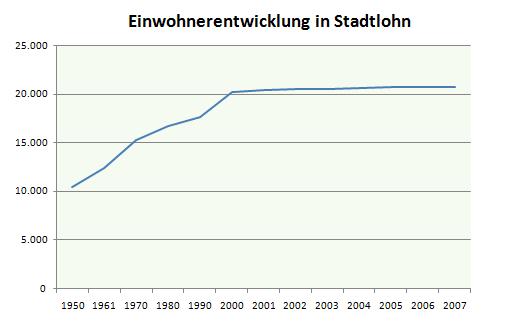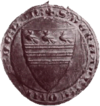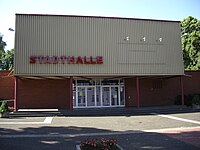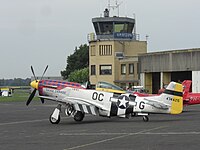City wages
| coat of arms | Germany map | |
|---|---|---|
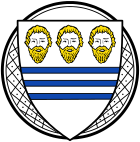
|
Coordinates: 52 ° 0 ' N , 6 ° 55' E |
|
| Basic data | ||
| State : | North Rhine-Westphalia | |
| Circle : | Bark | |
| Height : | 50 m above sea level NHN | |
| Area : | 79.25 km 2 | |
| Residents: | 20,283 (Dec. 31, 2019) | |
| Population density : | 256 inhabitants per km 2 | |
| Postal code : | 48703 | |
| Area code : | 02563 | |
| License plate : | BOR, AH, BOH | |
| Community key : | 05 5 54 056 | |
| LOCODE : | DE SLO | |
City administration address : |
Markt 3 48703 Stadtlohn |
|
| Website : | ||
| Mayor : | Helmut Könning ( CDU ) | |
| Location of the city of Stadtlohn in the Borken district | ||
The city Stadtlohn ( Low German Stadlaun ) located in the western Münsterland in the north-west of the country North Rhine-Westphalia and is a district town of Borken in Münster Region .
geography
Stadtlohn is located in the so-called Münsterland park landscape , whose special charm lies in the alternation of forest areas and agricultural areas.
Stadtlohn's highest point in the area is in the Wolters district in Wendfeld . It is 77 m above sea level. The deepest point of the terrain with 40 m above sea level is located in the Bockwinkel . This results in an average altitude of 50 meters above sea level. The highest building point in the city is the steeple of St. Otger Church at 124 meters above sea level.
The Berkel flows through Stadtlohn . It is one of the few rivers in the Münsterland that is largely unregulated in its bed. So a species-rich, significant flood plain was preserved. Among other things, the entire length between Stadtlohn and Vreden is under nature protection. Among other things, the rare kingfisher occurs here.
City structure
The city is divided into nine districts: Stadt, Hengeler, Wendfeld , Almsick , Hordt, Esch, Wenningfeld, Hundewick , Estern and Büren .
Neighboring communities
Neighboring Stadtlohn in the Borken district are the communities Südlohn , Vreden , Ahaus , Legden and Gescher .
history
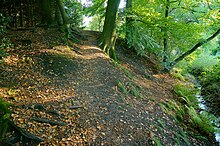
Archaeological finds both in Stadtlohn and in the geographic area indicate a prehistoric and early historical settlement area. The Hünenburg in the so-called Bockwinkel with its ramparts and ditches is a comparatively well-preserved hill fort from the Carolingian era (8th / 9th century AD).
Stadtlohn, then still called Lohn, was the center of a court association of the Prince-Bishop of Münster. Werner von Steußlingen , who was Bishop of Münster from 1132 to 1151 , had a castle built there to secure the diocesan borders between St. Otger and Berkel, which he gave to the noble lords of Lohn as a fief . In 1193, Lohn Castle was destroyed for unknown reasons by Hermann II von Katzenelnbogen (1174–1203), who is considered the first prince-bishop of the Münster bishopric . However, it must have continued to exist to a certain extent after 1193, because it was a residence of the Counts of Lohn until the 14th century. With the parish of Südlohn in 1231, the designation Nordlohn for wages prevailed until the town was first mentioned in 1389 under the name Stadtlohn after the elevation to Wigbold .
Around 1611 a major fire ravaged the city. Armed conflicts in the 16th and 17th centuries also had devastating consequences for Stadtlohn and its residents. In this context, the battle in the Lohner Bruch is worth mentioning. It took place on August 6, 1623. Opponents were the imperial general Tilly , who won the battle, and the Duke Christian of Braunschweig , also known as the great Christian . Six years later, the city council decided to downsize the city for strategic reasons. The separated settlement area was henceforth the Butenstadt .
For a longer period of time, Stadtlohn was also a place of pilgrimage . The pilgrimage chapel on Hilgenberg , built in 1695 and expanded in 1738, bears witness to this.
Agriculture shaped the life of the small town until 1800. Most of the so-called arable citizens were also artisans. Since time immemorial, the pottery and linen weaving trade have held a special position . Both crafts - albeit in an industrialized form - are still alive today in Stadtlohn. A regional peculiarity with regard to the pottery trade is the formerly numerous use of stacking aids, the so-called Stadtlohner straps , as flooring.
Stadtlohn was almost completely destroyed by bombing raids in March 1945. The city was rebuilt in the post-war period. In addition to the existing textile industry, production facilities for the wood and metal industries were built. In the development plan of the state of North Rhine-Westphalia, Stadtlohn is now considered a medium-sized center for supplying around 50,000 citizens.
On August 1, 1964, the parish parish Stadtlohn was newly formed from the previous parishes of Almsick , Estern-Büren , Hengeler-Wendfeld , Hundewick and Wessendorf . On July 1, 1969, it was incorporated into the city of Stadtlohn by the law on the reorganization of municipalities in the Ahaus district.
Population development
The population of Stadtlohn rose sharply between 1950 and 2000.
Churches and religious communities
Around 16,800 residents of Stadtlohn belong to the Roman Catholic Church . Today's parish of St. Otger is the result of a merger of three parishes (St. Joseph, St. Karl-Borromäus and St. Otger himself).
The Protestant parish was established around 1900 . Around 1,500 city wage workers belong to it. Your spiritual center is the Pauluskirche. Today, as the parish of Stadtlohn, it is part of the Protestant parish of Oeding – Stadtlohn – Vreden.
In addition, a congregation of the Syrian Orthodox Church has emerged. It has around 100 members.
In the meantime, other religious communities have their meeting places in Stadtlohn - including an Islamic religious community.
politics
City council and mayor
Since the last local election on May 25, 2014 , the following parties and voter communities have been represented in the city council:
The CDU provides the mayor with Helmut Könning .
coat of arms
Blazon: In silver, three blue thread bars one above the other, three times next to each other the bearded head of St. Paul .
Stadtlohn's coat of arms goes back to the family coat of arms of the Lords of Lohn. The Lohner coat of arms showed a shield with three bars and three birds walking to the right in the shield head. In 1316 the reign of Lohn came to the Prince-Bishop of Münster. In the city's first seal from the 16th century, three heads of Paul appear in place of the three birds. Paul was the patron saint of the Münster monastery. The three number of heads is explained by the number of birds and is also intended to remind us that, according to legend, the head of St. Paul rose from the ground three times after he was beheaded. The first depiction of the coat of arms can be seen on a seal imprint of the Counts of Lohn (from 1289).
Town twinning
Stadtlohn has partnerships with Weerselo (municipality of Dinkelland) , the Netherlands (since 1973), San Vito al Tagliamento , Italy (since 1983) and Altlandsberg .
Weerselo is located in the north-eastern part of the Twente region about 60 kilometers north of Stadtlohn. As part of a local government reform, the municipality of Weerselo became part of the Dinkelland municipality in 2001, which currently has around 26,000 inhabitants. San Vito is located in northern Italy, about 70 kilometers from Venice and has about 13,000 inhabitants. Since 2010 the Jugendwerk Stadtlohn e. V. organized a youth meeting in San Vito. Every summer a delegation of young people sets out to meet Italian young people in San Vito.
After the fall of the Berlin Wall , there was a lively exchange between the town of Altlandsberg and Stadtlohn, which resulted in a friendship between the towns. Altlandsberg is located east of Berlin in Brandenburg and has about 8,750 inhabitants.
Culture and sights
Stadtlohn has a number of sights and cultural offers.
Sacred buildings
The St. Otger Church is built from Baumberger sandstone . The first written documents in which the church is mentioned date from the 12th century. Inside the church, pillar arches bear the weight of the roof and the tower. The sacred building was destroyed several times by fires and the effects of war, but it was rebuilt again and again.
The St. Joseph Church is based on a design by the Stadtlohn architect Heinrich Frericks. The foundation stone was laid on May 1, 1961 and the consecration took place on January 13, 1963. Like many churches from the 1960s and 1970s, it is relatively simple. Preferred building materials are brick and concrete. The tower of the church is a few meters from the nave.
The St. Karl Borromeo Church in the Büren district was built in 1914 to provide for the church in Büren.
The Hilgenberg Chapel was built in 1695 and was an important pilgrimage destination in the Münsterland until 1886 . The consecration of St. Laurentius Chapel in Hengelborg House in the Estern district took place in 1717. The chapel belonging to the hospital and the Paulus Church of the Protestant parish built in the 1950s are also worth seeing.
Secular buildings
The Hakenfort house is the oldest non-sacred building in Stadtlohn. In this house, built in 1808, which is also used as an exhibition room and concert hall, the SMS-StadtMarketing Stadtlohn e. V. with the tourist information.
The old Stadtlohn water tower, visible from afar , was built before the Second World War and is now used as a residential building.
Other public buildings are the town hall with space for 700 to 1000 visitors and the town hall, built in 1953.
Soil monuments
- In Bockwinkel, about three kilometers from the city center, lies the Hünenburg , a Carolingian ring wall. It was built around 775 and was of strategic importance for controlling the way from the IJssel to the Münsterland.
- There is also a tower hill in the Almsick peasantry, which is believed to date from the High Middle Ages.
Museums
music
A whole series of music bands and marching bands operate in Stadtlohn, including the Stadtlohner Husarenkapelle 1898 e. V. , the Stadtlohner Musikkapelle Wiesentaler - 1900 e. V. , the marching band of the carnival society “Üm Bütt un Pütt” and the fanfare march of the city guard of the carnival society “Üm Bütt un Pütt” and the Drumpets e. V. The Stadtlohner Rockinitiative (STaR) plays a special role among the other music groups and bands . The male choir Stadtlohn 1922 e. V. is one of the city's cultural bearers. A choir group exists under the name of OHRwürmer Stadtlohn . Lovers of classical music will find a suitable offer at the Stadtlohn Klassik concert series . In midsummer, open-air operas are performed on the market square in front of St. Otger's Church, preferably works by Verdi and Mozart.
The musical offspring is trained in the Stadtlohner Musikschule and as part of the concept of the Stadtlohner Musikkapelle Wiesentaler.
Sports
Sport has a high priority in Stadtlohn. Around 10,000 members are organized in over 25 sports clubs, including around 3000–4000 young people and over 200 trainers. Stadtlohn owns two large clubs for popular sports : DJK Eintracht and SuS Stadtlohn . Various smaller clubs specialize in individual sports (for example: sport shooters , TG Almsick etc.). Athletes and those interested in sports are u. a. eleven club and public tennis courts, nine soccer fields, two triple sports halls, seven school sports halls, two shooting sports facilities, a judo center and even a motor, glider and parachute landing area are available. There is also an outdoor trial area as a facility for cyclists.
In addition, there is a public indoor pool and an outdoor pool for swimming in Stadtlohn, which the DLRG local group Stadtlohn and SuS Stadtlohn also use for club sports.
Regular events
-
Shooting festivals
- in the city: Bürgererschützenverein Stadtlohn 1482 e. V., St.-Georgius-Schützengilde, Bürgererschützenverein “former Wessendorfer” St. Otgerus Schützengilde Stadtlohn e. V.
- Farmerships and parishes: Shooting clubs Hundewick, Hengeler, Wessendorf, Wessendorf-Breul, Estern, Büren, Almsick, Wendfeld
- Carnival : Büttabende and street and pubs carnival of Indian until Carnival Tuesday parade on Carnival Monday . Carnival call : "De un da" , derived from Low German: De uniesen Daage (The foolish days).
- Stadtlohn is in bloom : the second weekend of shopping in March with a focus on gardens, cars and spring.
- Stadtlohner Frühling : Children's flea market in the city center and shopping weekend on the third weekend in April.
- City run : on the Friday before the Stadtlohn spring
- Stadtlohner tennis tournament : from the Thursday before Pentecost to Whit Monday
- International Nachtuhlen cycle race : with many well-known amateur cyclists, on the Friday before the fair weekend.
- Stadtlohn pilgrimage day : on the first Sunday in July after the feast of the Visitation of the Virgin Mary to the Hilgenberg chapel.
- Stadtlohner Kirmes : always on the first weekend in July (Saturday to Monday; on Monday with Krammarkt)
- Stadtlohner Reitertage : first weekend in August
- Dodgeball Beach Cup : every second weekend in August - the largest dodgeball event in the world
- Potato tour: 3rd Sunday in August, bike tour for everyone around Stadtlohn along shelters and rest huts in which culinary everything about potatoes is offered.
- Stadtlohner Herbst : Shopping Saturdays and Sundays. The date is the third weekend in September.
- Kiepenkerl-Sonntag : Meeting of the Kiepenkerle from the region, always on the third weekend in October with Saturday and Sunday open for shopping. In addition, representation of old craftsmanship and services as well as old traditions.
- Christmas market : in the third week of Advent
- New Year's Eve run : on New Year's Eve morning with student routes of 1,200 and 2,400 meters and main routes of 8 km and 15 km
Economy and Infrastructure
- Woodworking companies z. E.g .: Hülsta
- Textile processing companies z. E.g .: H. Hecking sons
- Agricultural equipment and vehicle construction z. E.g .: Kemper, Dücker, Deitmer Maschinenbau
- Metal construction / manufacturing e.g. E.g .: Lichtgitter , Günther Wensing GmbH & Co. KG, Ferro, Sicking
- Media company z. E.g .: RFS MediaGroup
- many small and medium-sized companies in various industries
- Stadtlohn owns three major industrial areas
- The first industrial area is in the eastern part of the city, along the L 608
- Another industrial area is located in the southwest of Stadtlohn, between L 572 and Westfalenring (bypass)
- The third and largest industrial area is in the west of the city between the K 20 and the L 572
- Other companies are located all over the city in mixed industrial and residential areas. Further enlargements of the existing industrial areas are planned.
The Sparkasse Stadtlohn was incorporated into the Sparkasse Westmünsterland with effect from January 1, 2011 .
traffic
Road traffic
Since January 1, 2010, Bundesstraße 70 has been downgraded to Landesstraße 572 by Stadtlohn , while the previous L 572 was upgraded to Bundesstraße in return. The latter also crosses the Stadtlohn area. State road 608 and several district roads also run through Stadtlohn. The next motorway, the A 31 , is around 10 km away.
Bicycle traffic
Stadtlohn is connected to the following regional and supraregional cycle routes: to the European cycle route R1 (from France to Russia, among others via Vreden, Münster, Höxter and Berlin), to the Flamingo route, to the Berkel route and to the agri-cultura route.
Air traffic
The Stadtlohn-Vreden airfield , which is classified as a commercial airfield, is located on the city limits of Vreden . The airfield is used for commercial and non-commercial powered flight and glider flight. The length of the runway is 1200 meters with a width of 30 meters. The nearest airports are Düsseldorf Airport and Münster / Osnabrück Airport , both around an hour's drive from Stadtlohn.
Rail transport
The Borken – Burgsteinfurt railway , which was operated by Westfälische Landes-Eisenbahn GmbH, ran through Stadtlohn from 1902. The 9.2 km branch to Vreden branched off from here. This is where the Stadtlohn-Wenningfeld and Stadtlohn-Wessendorf stops were located . Passenger traffic between Stadtlohn and Vreden was terminated on May 31, 1958, and from September 27, 1975, only freight trains were still in use on the rest of the route. The entire operation ended on March 31, 1988, followed by the dismantling of the track system.
Bus transport
Regional buses run every hour to Coesfeld and Vreden , and every half an hour to Borken (Westphalia) via Südlohn and to Ahaus, every hour to Gronau. In Borken and Coesfeld there is a system connection to the rail lines to Essen and Münster.
The Südlohn – Oeding community bus also runs to various outdoor stops on the Stadtlohn – Südlohn – Oeding– Winterswijk route .
The night bus connects Stadtlohn with Münster via Coesfeld on the weekends.
education
In preschool seven kindergartens work ( Family Center St. Otger, St. Nicholas Kindergarten, St. Mary's kindergarten, St. Joseph Kindergarten, St. Elisabeth kindergarten, Don Bosco kindergarten, die Kinderburg- Kindergarten ), three day care centers ( DRK Family Center Prinz Botho, Kindergarten Erste Eltern-Kind-Gruppe e.V., Kita Spielkiste Stadtlohn e.V. ) as well as the daycare center Stadtlohn-Vreden-Südlohn .
For the general education four primary schools provide ( Hilgenberg school Gescher Dyk School, Fliedner school Hordtschule ), the special school Johannesschule with a program focusing on learning, language, emotional and social development was closed in 2014, a secondary school ( Losbergschule ), two intermediate schools (the private St. Anna Realschule , Herta-Lebenstein-Realschule ), a high school ( Geschwister-Scholl-Gymnasium ) and a vocational school ( Lise Meitner vocational college ).
The public educational institutions in Stadtlohn include an adult education center , a music school and a public library .
Personalities
sons and daughters of the town
- Erhart Küng (around 1420 – before 1507), foreman at the Bern Minster
- Bernd Rothmann (1495 – after 1535), leader of the Anabaptist movement
- Clemens Blanke (1895–1945), mayor of Stadtlohn, NSDAP district leader in Ahaus
- Erich Jansen (1897–1968), writer
- Bernhard Kötting (1910–1996), professor of church history
- Hans Martin (1925–2006), owner of the Lichtgitter-Gesellschaft and holder of the Federal Cross of Merit
- Karl Hüls (1930–2001), founder of the Hülsta-Werke Hüls and honorary citizen of the city of Stadtlohn
- Hubert Frankemölle (* 1939), New Testament theology professor
- Karl-Heinz Hornhues (* 1939), politician (CDU)
- Helmut Könning (* 1952), Mayor of Stadtlohn
- Paulus Terwitte (* 1959 as Bernhard Terwitte), Catholic religious
- Maria Beerlage (* 1963), double world champion in art cycling
- Nicolai Kobus (* 1968), poet
- Jochen Taubert (* 1968), director, film editor, actor
- Ingrid Laubrock (* 1970), jazz musician
- Patrick Bittner (* 1971), cook
- Maurice Summen (* 1974), musician, label owner, author
- Henning Siemens (* 1974), handball player
literature
- City of Stadtlohn (Ed.):
- City wages in pictures
- City wages at zero hour
- City wages - when nothing worked anymore
- The battle in the Lohner Bruch near Stadtlohn on August 6, 1623
- Photographic memories
- City wages under the swastika
- Ulrich Söbbing (Red.): On your word ... - 1200 years of Christians in Stadtlohn . Published by the Catholic parish of St. Otger. Grosse Frericks, Stadtlohn 2000.
Web links
- Website of the city of Stadtlohn
- City map with pictures of the streets and houses
- Leonhard Sladeczek: The city of Lon , new insights into the medieval city and Wigbold development of Stadtlohn
- Link catalog on the subject of city wages at curlie.org (formerly DMOZ )
- City wages in the Westphalia Culture Atlas
Individual evidence
- ↑ Population of the municipalities of North Rhine-Westphalia on December 31, 2019 - update of the population based on the census of May 9, 2011. State Office for Information and Technology North Rhine-Westphalia (IT.NRW), accessed on June 17, 2020 . ( Help on this )
- ↑ a b Ulrich Söbbing: Foray through the city history of Stadtlohn on the website of the Heimatverein Stadtlohn.
- ↑ Stephanie Reekers: The regional development of the districts and communities of Westphalia 1817-1967 . Aschendorff, Münster Westfalen 1977, ISBN 3-402-05875-8 , p. 284 .
- ↑ http://wahlen.stadtlohn.de/kw2014/result.html
- ↑ Stadt Stadtlohn: 27 - Tower Hill (Klockenbülten in Almsick). Retrieved January 28, 2018 .
- ↑ Münsterland e. V .: Cycling in Stadtlohn | Münsterland e. V. Tourism. Retrieved June 3, 2017 .










